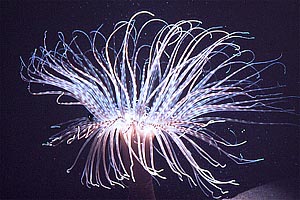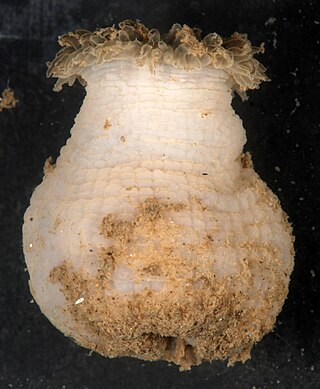
Anthozoa is a class of marine invertebrates which includes the sea anemones, stony corals and soft corals. Adult anthozoans are almost all attached to the seabed, while their larvae can disperse as part of the plankton. The basic unit of the adult is the polyp; this consists of a cylindrical column topped by a disc with a central mouth surrounded by tentacles. Sea anemones are mostly solitary, but the majority of corals are colonial, being formed by the budding of new polyps from an original, founding individual. Colonies are strengthened by calcium carbonate and other materials and take various massive, plate-like, bushy or leafy forms.

The starlet sea anemone is a species of small sea anemone in the family Edwardsiidae native to the east coast of the United States, with introduced populations along the coast of southeast England and the west coast of the United States. Populations have also been located in Nova Scotia, Canada. This sea anemone is found in the shallow brackish water of coastal lagoons and salt marshes where its slender column is usually buried in the mud and its tentacles exposed. Its genome has been sequenced and it is cultivated in the laboratory as a model organism, but the IUCN has listed it as being a "Vulnerable species" in the wild.

The southern stingray is a whiptail stingray found in tropical and subtropical waters of the Western Atlantic Ocean from New Jersey to southern Brazil. It has a flat, diamond-shaped disc, with a mud brown, olive, and grey dorsal surface and white underbelly. The barb on its tail is serrated and covered in a venomous mucus, used for self-defense.

Sea anemones are a group of predatory marine invertebrates of the order Actiniaria. Because of their colourful appearance, they are named after the Anemone, a terrestrial flowering plant. Sea anemones are classified in the phylum Cnidaria, class Anthozoa, subclass Hexacorallia. As cnidarians, sea anemones are related to corals, jellyfish, tube-dwelling anemones, and Hydra. Unlike jellyfish, sea anemones do not have a medusa stage in their life cycle.

Lagis koreni, commonly known as the trumpet worm, is a species of marine polychaete worm found in European waters. It lives within a narrow conical tube made of grains of sand and shell fragments.

Metridium senile, or frilled anemone, is a species of sea anemone in the family Metridiidae. As a member of the genus Metridium, it is a type of plumose anemone and is found in the seas off north-western Europe and both the east and west coasts of North America.

Cerianthus is a genus of tube-dwelling anemones in the family Cerianthidae. Members of the genus are found worldwide. They are predators, scavengers and omnivores.
Cerianthus lloydii is a species of tube-dwelling sea anemone in the family Cerianthidae. It is sometimes called the lesser cylinder anemone and is found in shallow seas around the coasts of north west Europe.

The burrowing anemone is a species of tube-dwelling anemone in the family Cerianthidae.

Cerianthus filiformis is a species of tube-dwelling sea anemone in the family Cerianthidae. It is found throughout the tropical waters of the western Indo-Pacific Ocean.
Squilla empusa is a species of mantis shrimp found in coastal areas of the western Atlantic Ocean. It excavates and occupies a burrow in soft sediment from which it emerges, mainly at night, to feed on fish and invertebrate prey.

Cerianthus membranaceus, the cylinder anemone or coloured tube anemone, is a species of large, tube-dwelling anemone in the family Cerianthidae. It is native to the Mediterranean Sea and adjoining parts of the northeastern Atlantic Ocean.

Ceriantheomorphe brasiliensis is a species of tube-dwelling anemones in the family Cerianthidae. It is found in the tropical western Atlantic Ocean, the Caribbean Sea and the Gulf of Mexico. It is currently listed as endangered based on a lack of evidence.

Diadumene cincta is a small and delicate, usually orange, sea anemone. It has a smooth slender column and up to 200 long tentacles, and normally grows to a length of up to 35 mm (1.4 in), with a base of 10 mm (0.4 in), but specimens twice this size have been recorded. Diadumene cincta is found in the northeastern Atlantic Ocean.

Haloclava producta is a species of sea anemone in the family Haloclavidae, commonly known as the ghost anemone. This species is native to shallow water in the northwestern Atlantic Ocean, between Cape Hatteras and the Bay of Fundy, where it makes a temporary burrow in soft sediment. It is found on sand flats, both intertidally and subtidally.

Paranthus rapiformis, the onion anemone, is a species of sea anemone in the family Actinostolidae. It was first described by the French naturalist Charles Alexandre Lesueur in 1817 and is native to the northwestern Atlantic Ocean and the Gulf of Mexico.

Edwardsia neozelanica, commonly known as the burrowing anemone, is a small cryptic sea anemone from New Zealand. It burrows into soft mud or sand, and when covered with water extends its tentacles to feed on tiny particles of detritus.

Paraleptopentacta elongata is a species of sea cucumber in the family Cucumariidae. It is found in the northeastern Atlantic Ocean and parts of the Mediterranean Sea. It is an infaunal species, occupying a burrow in the seabed, from which its anterior and posterior ends project.

Actinostella flosculifera, the collared sand anemone, is a species of sea anemone in the family Actiniidae. It is found semi-immersed in the sediment in shallow water in the tropical and subtropical Atlantic Ocean.

















